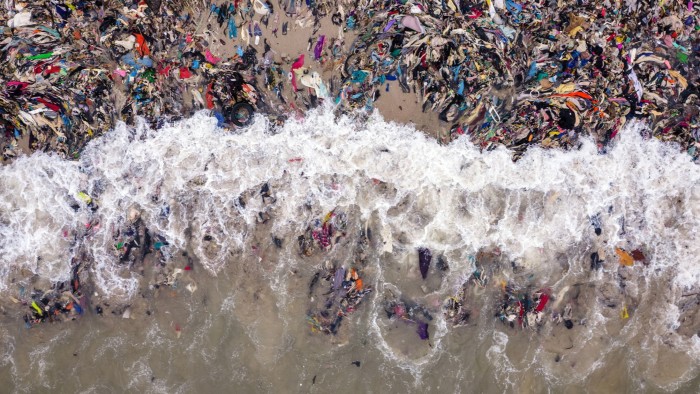In Ghana, sea turtle nesting grounds have become clothing dumpsites. The majestic animals are famous for travelling thousands of miles in the ocean and returning to lay their eggs on the exact beach where they were first hatched. In recent years, they’ve become unable to navigate the sand once they reach the shore in some places, according to Solomon Noi, director of waste management at the Accra Metropolitan Assembly, because used clothing imported largely from Europe has littered the beach so thoroughly.
In India, waste pickers make a living scouring dumpsites for recyclable materials that they can sell. During the past few years, their job has become harder because of clothing; it’s added a whole new layer that they have to dig through to find materials they can sell.
In Indonesia, used clothes have been distributed to survivors of volcano eruptions, earthquakes and other natural disasters. Yet there is still far more than people want or need, and clothes have piled up so heavily that the country is now considered one of fashion’s many “dumping grounds”.
The reality is that there are more clothes in the world than there are people to wear them. The effects are personal and profound for millions of people, damaging to local economies and devastating for natural ecosystems.
If the fashion industry faced consequences for contributing to the world’s waste problem, would it change its ways?
Governments are betting yes. From California to the EU, legislators are moving ahead with a concept known as extended producer responsibility (EPR), which aims to hold brands accountable for what happens to the products they put out into the world.
Here’s how it works: brands pay a fee for every product they sell. Those fees contribute to an independently run fund that’s used to cover the costs of collecting used clothing, developing infrastructure to recycle it into new fibres or processing it for reuse, repair or some other form of “responsible” disposal.
The trouble is, the success of an EPR programme hinges on how all of those terms are defined and who oversees their implementation. Who decides whether a garment is actually reusable? What does recycling mean, considering textile-to-textile recycling is not yet a commercial reality? How much of a fee do brands pay exactly — and is it enough to meaningfully improve how waste is managed? And do EPR funds follow a garment wherever it ends up or do they remain in the municipality that collected them?
An EPR programme that doesn’t fully address these questions risks not only squandering the chance to reduce waste — but increasing the quantities that get shipped elsewhere.
Worse, some say the concept of EPR in itself is flawed, because while it may prolong the time a product spends in circulation before it is considered waste, it doesn’t create real solutions for when that day does come. “EPR screams end of life, and you’re never going to have an end of life solution for textiles. We need a front of life [solution]. We know what the problem is — there’s too much of it,” says Jan Dell, a chemical engineer considered an expert in plastic waste. For her, reducing total production volumes is the only viable path forward.
But as long as the fashion industry is operating as it is, EPR is generally considered a necessary step to rein in the harm it causes.
In the EU, the Waste Framework Directive, which is expected to be adopted into law in October, will require member states to establish EPR schemes.
Waste advocates have applauded the bill, which is the first of its kind for the apparel industry. A particular bright spot is that it includes a mechanism to “eco-modulate” the fees a brand has to pay and that it bases the size of the fee not only on the environmental impact of a product, such as whether it is made with low-carbon or recyclable materials, but also on a company’s commercial practices such as the speed and volume with which it releases new styles. That could disincentivise rampant overproduction, potentially prompting fast fashion companies to re-evaluate their business models because if they continue to produce vast volumes, the EPR fees would hit them hardest.
Disappointing, though, is the lack of a mechanism for EPR funds to be transferred across borders, says Emily Macintosh, senior policy officer for textiles at the European Environmental Bureau, a network of environmental organisations in Europe. That’s a necessary provision for what the Ghana-based Or Foundation has described as “globally accountable” EPR. Macintosh adds that there might be nothing to stop an EU member state from distributing EPR-generated funds to countries or regions that receive Europe’s exported textiles — “it just might be unlikely that they would do so if not ‘asked’ to by the Directive,” she says.
If EPR funds don’t follow the flow of used garments, she worries that the same dynamics playing out with clothing waste today will remain unchanged: waste pickers in India will face more gruelling manual labour because other countries didn’t manage their own clothing excess better. Beaches in Ghana will continue to be polluted with local communities bearing the physical, emotional and economic burden of cleaning them up. Victims of natural disasters in Indonesia will struggle to not only survive, but now to also manage other people’s old clothes.
These are significant and tangible costs that clothing manufacturers should be covering, she and other advocates say — not the communities on the receiving end of their waste.
In California, an EPR programme is in the works thanks to a bill passed last year. The most urgent question for Joanne Brasch, director of advocacy and outreach at the California Product Stewardship Council, and for many others following the bill, is who will make up the Producer Responsibility Organisation (PRO), which is the body assigned to oversee an EPR programme.
It’s a high-stakes question because the details for an EPR programme, and the enforcement of its provisions, fall into the hands of the PRO.
“What matters most is that the PRO structure reflects real-world expertise, diverse business models and broad stakeholder input — not just legacy voices or default institutions,” said Rachel Kibbe, founder and chief executive officer of Circular Services Group and American Circular Textiles, a coalition advocating for responsible US policy.
For Liz Ricketts, co-founder of the Or Foundation in Ghana, the starting point for most questions relating to EPR is the size of the fee that brands are required to pay. If it’s too low, it can’t fund any service or infrastructure development that’s meaningful. If it’s significant enough (the Or Foundation argues it should range from $0.50 to $2.50 per item), it can be transformational — shifting the incentives with which brands operate and also covering the needs of communities involved in processing waste both at home and overseas.
“The only way this works is if the EPR fee is high enough that it doesn’t breed competition. As long as the pie is small, everyone is fighting over resources,” she says. But the fee — and the size of the total pie — can be as large as an EPR programme allows it to be. The question for lawmakers is, how large is that?
Follow us on Instagram and sign up for Fashion Matters, your weekly newsletter about the fashion industry


